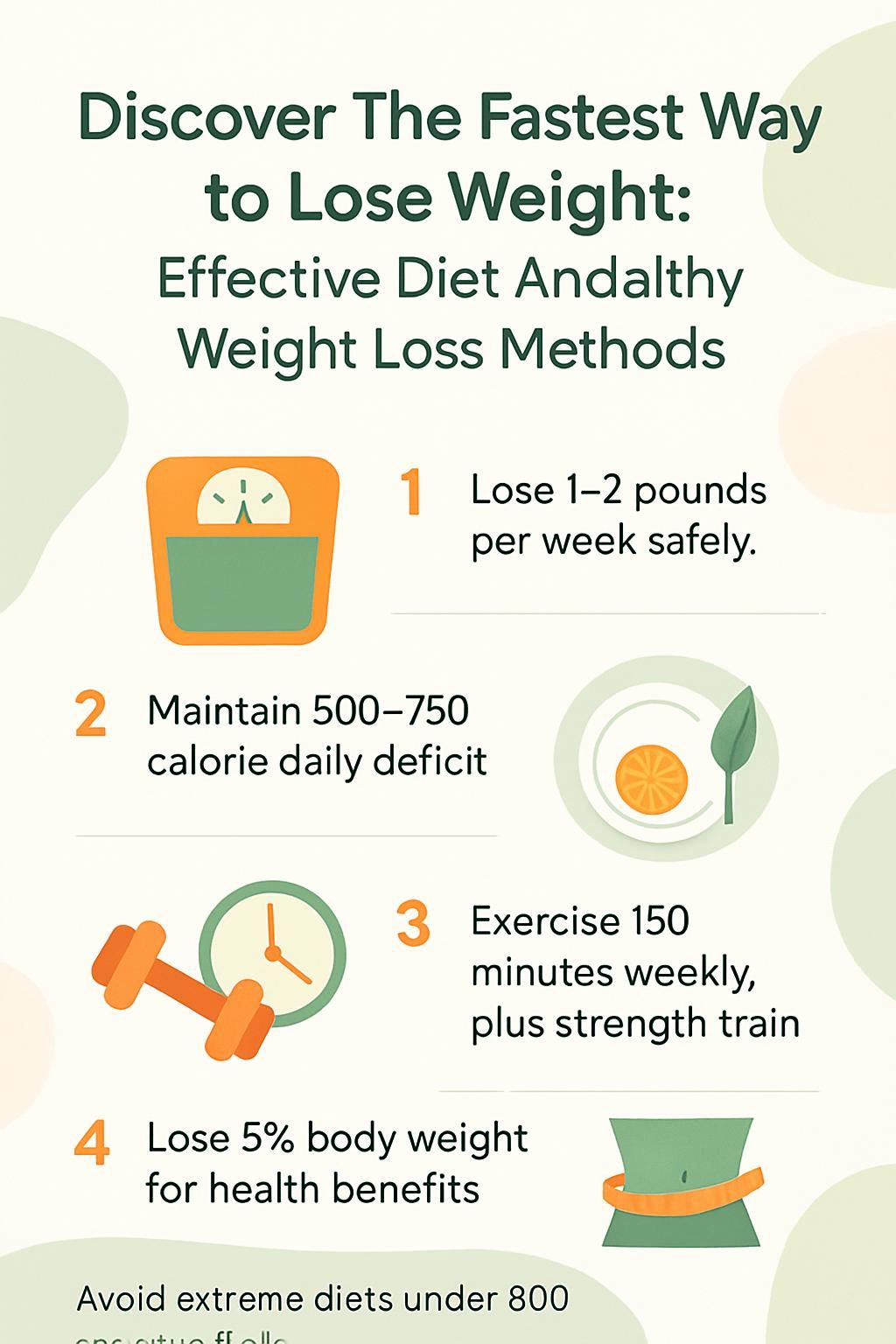Discover The Fastest Way To Lose Weight: Effective Diet And Healthy Weight Loss Methods
Our Nutrition Assistant AI Suite will transform your body. You will lose fat, get toned, and build muscle. Gain confidence and optimal health.
You want results fast, yet you also want to lose weight safely. The quickest healthy path is not a crash diet. It is a simple plan that blends smart food choices, regular physical activity, and small lifestyle tweaks.
This guide shares science-backed weight loss tips from trusted sources like the Centers for Disease Control and Prevention and the Mayo Clinic. You will learn how balanced meals, steady movement, and real-world habits can help you reach your weight loss goals sooner and keep the progress.
Start today with steps that fit your life and schedule.
Key Takeaways
- A safe pace is 1–2 pounds per week, which helps protect muscle and builds lasting habits.
- A steady calorie deficit of 500–750 per day, balanced nutrition, portion control, plants, and enough protein support long-term results.
- At least 150 minutes of moderate exercise weekly plus strength training twice a week supports metabolism and helps prevent regain.
- Losing 5 percent of body weight can lower risk for heart disease and type 2 diabetes and can boost energy.
- Very low-calorie diets under 800 calories can cause muscle loss or gallstones. Seek medical care before any rapid method.

Understanding Healthy Weight Loss

Quick results are tempting, but healthy weight loss is about changes you can live with. Evidence shows steady progress helps you shed excess weight and protect your health over time.
Why is sustainable weight loss important?
Sustainable weight loss helps you avoid yo-yo dieting and frequent regain. Obesity raises your risk for heart disease, type 2 diabetes, stroke, kidney disease, and some cancers.
Experts recommend losing 1 to 2 pounds, or 0.5 to 1 kilogram, per week. This pace protects lean muscle, keeps your metabolism steady, and supports lasting habits. Research links slow, steady loss with better blood sugar control, healthier cholesterol, and less belly fat.
You also gain energy, which makes regular physical activity and strength work easier. Setting realistic targets keeps motivation strong and your routine doable.
Small daily improvements are the key to big long-term results. Unknown
Before you pick a plan, clear up the most common myths about rapid weight loss.
What are common myths about losing weight fast?
Many ads promise a way to lose 10 pounds in a week or losing 20 pounds with a fad diet. These plans often rely on extreme calorie cuts, which can harm health and lead to quick regain.
Very low-calorie diets can change hormones that control appetite and fat storage. That can promote weight cycling. Pills and special foods do not burn fat without a healthy diet and movement. Fad diets often lack key nutrients and dietary fiber from vegetables, fruits, and whole grains.
Health groups and registered dietitians advise gradual fat loss with balanced eating and activity. Shortcuts rarely support healthy weight management for the long run.
Setting the Foundation for Success
A clear plan plus a ready mindset sets you up to succeed. Think of it as building a sturdy base before you add more floors.
How do you know if you’re ready to lose weight?
Readiness shows up as a strong desire to change daily habits. Ask yourself: Am I willing to adjust how I eat and move? Can I make time for meal prep, physical activity, and self-care? Do I often use food to cope with stress or emotions?
If work or family pressure feels overwhelming, manage those stressors first. Support increases your odds of success. Consider help from friends, a dietitian, or a counselor. Free tools like the United States Department of Agriculture MyPlate program can guide you.
Change happens when the pain of staying the same is greater than the pain of change.
How can you find your motivation to lose weight?
Write down why you want change. Maybe you want to lower heart disease risk or feel comfortable in your clothes. Keep these reasons where you will see them, like your fridge or mirror.
Track food, steps, and workouts in a journal or app. Surround yourself with people who support healthy choices. Join a walking club or a meal-prep group. Shared goals make it easier to stay on track.
How do you set realistic and achievable weight loss goals?
Once you know why you are ready, turn that into a clear plan. Use both outcome goals and action goals to guide your day.
- Target a loss of 1 to 2 pounds per week for safe progress.
- Create a daily calorie deficit of 500 to 750 with diet and movement.
- Start with 5 percent of your current body weight as your first milestone.
- Set outcome goals, like “lose 10 pounds,” and action goals, like “walk 30 minutes daily.”
- Track meals, portions, activity, and weight in a journal or app.
- Protect lean muscle and reduce belly fat with strength training and enough protein.
- If you plateau, adjust calories, portions, or activity after several weeks.
- Plan non-food rewards, such as new workout gear or extra reading time.
- Speak with a healthcare provider if you have conditions like diabetes or heart disease.
- Choose evidence-based diet strategies, such as plant-forward, lower-carb, or structured meal replacements.
Effective Diet Strategies for Weight Loss
Choosing a healthy diet that fits your life is the fastest way to lose weight safely. The best plan keeps you satisfied while creating a steady calorie gap.
How does calorie restriction and portion control aid weight loss?
Weight loss happens when you burn more energy than you eat. A daily deficit of 500 to 750 calories can lead to 0.5–1 pound per week. This rate helps your body use stored fat while protecting muscle.
Portion control prevents overeating. Stop eating when you feel comfortable, then save leftovers. Choose fresh foods over high calorie convenience items. They fill you up with fewer calories and help you stay on track.
What are nutrient-dense foods to include in your diet?
Nutrient-dense foods pack vitamins, minerals, and fiber with fewer calories. Build most meals from plants, then add lean protein and healthy fats.
- Vegetables: at least 4 servings daily, like broccoli, spinach, carrots, or peppers.
- Fruits: at least 3 servings daily, such as apples, berries, or oranges.
- Whole grains: choose oats, brown rice, or whole grain bread over refined grains.
- Dairy: pick low-fat or fat-free yogurt and milk for calcium and protein.
- Healthy fats: use olive oil or avocado in small amounts because they are calorie dense.
Aim for at least 5 total portions of fruits and vegetables daily, about 80 grams per portion.
What roles do protein, healthy fats, and fiber play in weight loss?
Protein helps you feel full and protects lean muscle during a calorie deficit. Good options include fish, poultry, beans, yogurt, and cottage cheese.
Healthy fats from olive oil, nuts, and avocados increase fullness. Use them in small amounts because they add up fast. Fiber from vegetables, fruits, legumes, and whole grains slows digestion. That steadies blood sugar and reduces cravings.
How do time-restricted eating and intermittent fasting work?
Time-restricted eating limits eating to certain hours. A common 16:8 plan means you eat for 8 hours, then fast for 16. Many people cut calories more easily by narrowing the eating window. This approach may improve insulin sensitivity, which helps your body handle glucose.
Intermittent fasting also includes the 5:2 pattern, where you eat normally for five days and restrict on two non-consecutive days. Studies show these methods can support quick early losses. Long-term results vary, so choose a style you can maintain.
Popular Diet Plans and Their Effectiveness
Many diets claim to be the most effective way to lose weight. Results can differ from person to person, based on taste, budget, and health needs.
What are Very Low-Calorie Diets (VLCD)?
A Very Low-Calorie Diet limits intake to 800 calories or less per day. Doctors may prescribe these plans for adults with obesity, sometimes before bariatric surgery. Most VLCDs use meal replacements, such as shakes or soups, to control calories and nutrients.
People often lose 3 to 5 pounds per week on a VLCD under medical care. These plans are short term, usually no more than 12 weeks, because they carry risks like muscle loss, nutrient gaps, and gallstones.
If you try a VLCD, do it only with medical supervision. For long-term success, graduate to a balanced plan you can follow daily.
How do Low-Calorie Diets (LCD) work?
Low-Calorie Diets reduce intake to about 1,200–1,500 calories for women and 1,500–1,800 for men. This creates a steady calorie gap, so your body uses stored fat for energy.
Many LCDs mix regular foods with meal replacements for simplicity. Some people feel tired at first, so medical guidance helps. LCDs often produce faster short-term loss than unstructured plans, as long as nutrients stay balanced.
What are the benefits of plant-based diets?
Plant-based diets focus on vegetables, fruits, whole grains, legumes, nuts, and seeds. They are high in fiber and tend to be lower in calories. This helps you feel full on fewer calories and supports weight management.
Research links plant-based eating to lower risk for heart disease and type 2 diabetes. Blood sugar control often improves because fiber slows the rise in glucose after meals.
How effective are low-carb and ketogenic diets?
Low-carb and ketogenic diets reduce carbohydrates and increase protein and fat. Many people lose more weight in the first 3 to 6 months compared to low-fat diets, according to several reviews.
These plans can feel strict. Some people regain weight after returning to old habits. If you try lower-carb eating, focus on non-starchy vegetables, quality protein, and healthy fats. Pick a level of carb reduction you can keep.
The Role of Exercise in Weight Loss
Exercise is a force multiplier for fat loss, mood, and energy.
What are the benefits of regular physical activity?
Regular physical activity burns calories and supports weight loss maintenance. Adults who complete at least 150 minutes of moderate exercise per week have lower risk for obesity, heart disease, and type 2 diabetes. Exercise also boosts mood and sleep quality.
Even simple steps help. Try brisk walks, cycling, or swimming. Small bursts add up over a week and make your plan easier to follow.
How do strength training and cardio compare?
Strength training builds lean muscle. Muscle burns more energy at rest, so it helps your metabolism. Aim for at least two strength sessions per week.
Cardio, like walking or biking, burns calories during the workout. A mix of both types helps you lose fat while protecting muscle. Most people do well with 30 minutes of cardio on most days plus two days of strength work.
How do you create a balanced workout routine?
A well-rounded routine supports weight loss and reduces injury risk. Combine endurance, strength, and flexibility to cover all bases.
- Get 150 minutes per week of moderate aerobic activity, like brisk walking or cycling.
- Add strength training 2 to 3 times weekly with squats, push-ups, bands, or weights.
- Stretch after sessions to improve range of motion and reduce soreness.
- Increase time or intensity as fitness improves to keep making progress.
- Choose activities you enjoy, such as dance classes or hikes, to stay consistent.
- Move more during the day. Take stairs, park farther away, or walk during calls.
- Track workouts in a journal or app to stay focused and see trends.
Many people find that pairing short walks with two weekly strength sessions keeps energy high and workouts sustainable.
Science-Backed Tips for Losing Weight Quickly and Safely
Small, consistent actions can speed results while keeping you safe.
How can mindful eating help weight loss?
Mindful eating means you pay attention to taste, texture, and fullness. Eating slowly can reduce total calories without strict rules. Putting your fork down between bites and checking your hunger level helps you avoid overeating.
Research suggests mindful eating can reduce binge episodes and support gradual weight loss (Harvard Health Publishing).
Source: Harvard Health Publishing, Mindful Eating, 2022.
Why is staying hydrated and drinking water before meals important?
Drinking two cups of water about 30 minutes before meals can help you eat fewer calories. Water takes up space in your stomach, so you feel full sooner.
Swap sugary drinks for water to cut added sugar and calories. A squeeze of lemon or lime adds flavor without extra sugar. Good hydration also supports exercise performance.
How do you track your progress and habits effectively?
Track meals, steps, and workouts in an app or notebook. Seeing the numbers keeps you honest and motivated. Reading food labels helps you compare options and pick lower calorie choices.
Set a daily movement goal, such as 30 minutes of activity. Review your data weekly to spot patterns like missed workouts or short sleep. Research supports self-monitoring as a core habit for lasting weight management.
Lifestyle Changes for Long-Term Success
Healthy routines turn short-term effort into steady progress.
How does managing stress prevent emotional eating?
Stress can push you to reach for high calorie comfort foods. That is emotional eating, not true hunger. Simple tools help. Try deep breathing, a short walk, or a quick stretch before you grab a snack.
If stress feels heavy, consider a counselor or a support group. Learning new coping skills reduces overeating and keeps your plan on track.
Sources: Harvard Medical School, Why Stress Causes People to Overeat, 2022; Healthline, How Stress Affects Your Body, 2020.
Why is prioritizing sleep important for metabolism?
Short sleep can raise hunger hormones and slow calorie burn. That makes weight control harder. Aim for 7 to 9 hours per night.
Regular exercise improves sleep quality, which then supports a healthy metabolism. With better sleep, food choices feel easier and cravings shrink.
How can building a supportive social network help weight loss?
Support makes change stick. Share your goals with a friend, join a walking group, or find an online community. Accountability helps you show up even on low-motivation days.
Studies report that people who join support programs are more likely to lose weight and maintain it over time.
Potential Risks of Rapid Weight Loss
Rapid weight loss can backfire if it costs you muscle or key nutrients.
What health concerns come from extreme diets?
Very strict diets can raise the risk of gallstones, gout, nutrient gaps, and low bone density. You may also lose muscle instead of fat. Cutting calories too far can slow your metabolism and increase the chance of regaining weight.
If you have medical conditions, seek care before any aggressive plan. Doctor-supervised programs can reduce risk and watch for side effects.
Why is losing lean muscle mass dangerous?
Muscle burns more calories at rest than fat. Losing muscle slows your metabolism and drains your energy. It can also make daily tasks harder.
Protect muscle with enough protein and regular strength training. This makes long-term weight management easier and keeps you strong.
Benefits of Healthy and Effective Weight Loss
Healthy weight loss improves how you feel, move, and think.
How does weight loss improve overall health and energy?
Even modest weight loss raises daily energy. Climbing stairs gets easier. Playing with kids feels more fun. Losing just 5 to 10 percent of body weight can ease strain on your heart and joints and often improves sleep and mood.
How does it reduce the risk of chronic diseases?
Shedding 5 percent of body weight can lower risk for heart disease and type 2 diabetes. Blood pressure and cholesterol often improve. Less belly fat means less stress on the liver and pancreas.
These changes help protect long-term health and make daily life more comfortable.
How does weight loss enhance mental well-being?
Physical activity and steady progress often lift mood and confidence. Exercise releases endorphins, your body’s natural feel-good chemicals. Support from friends or a group can reduce stress and improve follow-through.
Better sleep from healthier habits strengthens this positive cycle.
How to Stay Motivated During Your Weight Loss Journey
Motivation grows when you see progress and make plans for hard days.
How can you celebrate small milestones?
Mark wins like reaching 5 percent weight loss or sticking to daily walks for a week. Choose non-food rewards, such as new socks, a playlist, or a relaxing bath. Share your progress with a friend or in an app to keep momentum.
What can you learn from setbacks?
Setbacks happen. Treat them as feedback. Ask what triggered the slip, then adjust your plan. Maybe it is evening snacks, skipped meals, or stress.
People who restart after a slip tend to reach their goals over time. Small course corrections keep you moving forward.
Conclusion
Sustainable weight loss comes from a balanced diet, regular physical activity, and simple daily habits. A safe pace helps you lose weight, protect muscle, and keep results. Even a 5 percent drop in body weight can improve health risks and energy.
Choose evidence-based strategies that fit your life, track your steps, and build support around you. Speak with a healthcare professional, especially if you have medical conditions, before starting a new diet or exercise plan.
FAQs
1. What is the fastest way to lose weight using effective diet and healthy methods?
The most efficient approach combines a calorie-controlled eating plan with regular physical activity. Studies show that reducing daily caloric intake by 500 to 750 calories can help people lose about one to two pounds per week, which experts consider safe and sustainable.
2. Are certain foods better for healthy weight loss than others?
Whole grains, lean poultry, fish, beans, fruits, and vegetables support lasting weight control. Research from the National Institutes of Health suggests diets high in fiber and protein help you feel full longer while providing key nutrients.
3. How important is exercise when trying to lose weight quickly but safely?
Physical activity increases energy use and helps preserve muscle during fat loss. The Centers for Disease Control recommends at least 150 minutes of moderate aerobic exercise each week along with strength training twice weekly for best results.
4. Can personal experience affect how well someone loses weight on a specific diet?
Yes; individual responses vary due to genetics, lifestyle habits, or health conditions such as thyroid disorders or diabetes. For example, I found tracking meals helped me stay accountable while adjusting my food choices based on what worked best for my body’s needs.
Summary: Safe rapid weight loss relies on balanced nutrition paired with consistent movement tailored to your unique circumstances. Evidence supports gradual changes over extreme restrictions for long-term success.







